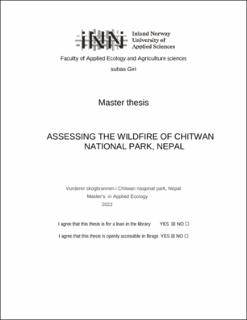| dc.description.abstract | Although fire has long been an Essent foremost of the forest ecosystem and has a significant impact on the flora and fauna, it is also widely believed to be one of the main causes of biodiversity loss and environmental deterioration. Furthermore, little study has been conducted on the timing and location of wildfires in Nepal. Because of this, Chitwan National Park is highly susceptible to wildfires (DFRS, 2015). For wildfire monitoring, detection, and management, geographic information systems (GIS) and remote sensing (RS) are frequently used. Quick and affordable solutions are produced through RS and GIS. United States Geological Survey Earth Explorer website was used to retrieve the Landsat image and digital elevation module. The ICIMOD website was used to acquire information on the study area's land use, land cover, road network, and population. A difference-normalized burn ratio (dNBR) was calculated using geographic information software to assess the severity of the burns and A multi-criteria weighted-overlay analysis was performed to determine the wildfire risk zone. Throughout the research period, 3617 fire events were reported in CNP, with 3135 of them taking place in the core region and 482 in the buffer zone. The variance in the mean value of fire frequency was examined using one-way ANOVA, and it was found that the number of wildfire occurrences during the summer months was substantially high (p-value less than 0.05 at the 5% level of significance). Since 2021 saw the most fire events in CNP from 2001 and 2021 (384 fire incidents), the severity of the year's burns was calculated. A total of 76558.68 hectares of forest were burned in CNP in 2021, per the burn severity study. The research indicates that there is a high risk of wildfire for 6391.6 hectares in CNP, a moderate risk for 154054.4 hectares, and a low risk for 7754.02 hectares. Most events took place in the core area, which was the consequence of deliberate fire used to manage grasslands and slow down succession. However, prevention is advised since it might impair the species that depend on a specific grassland ecosystem. | en_US |
